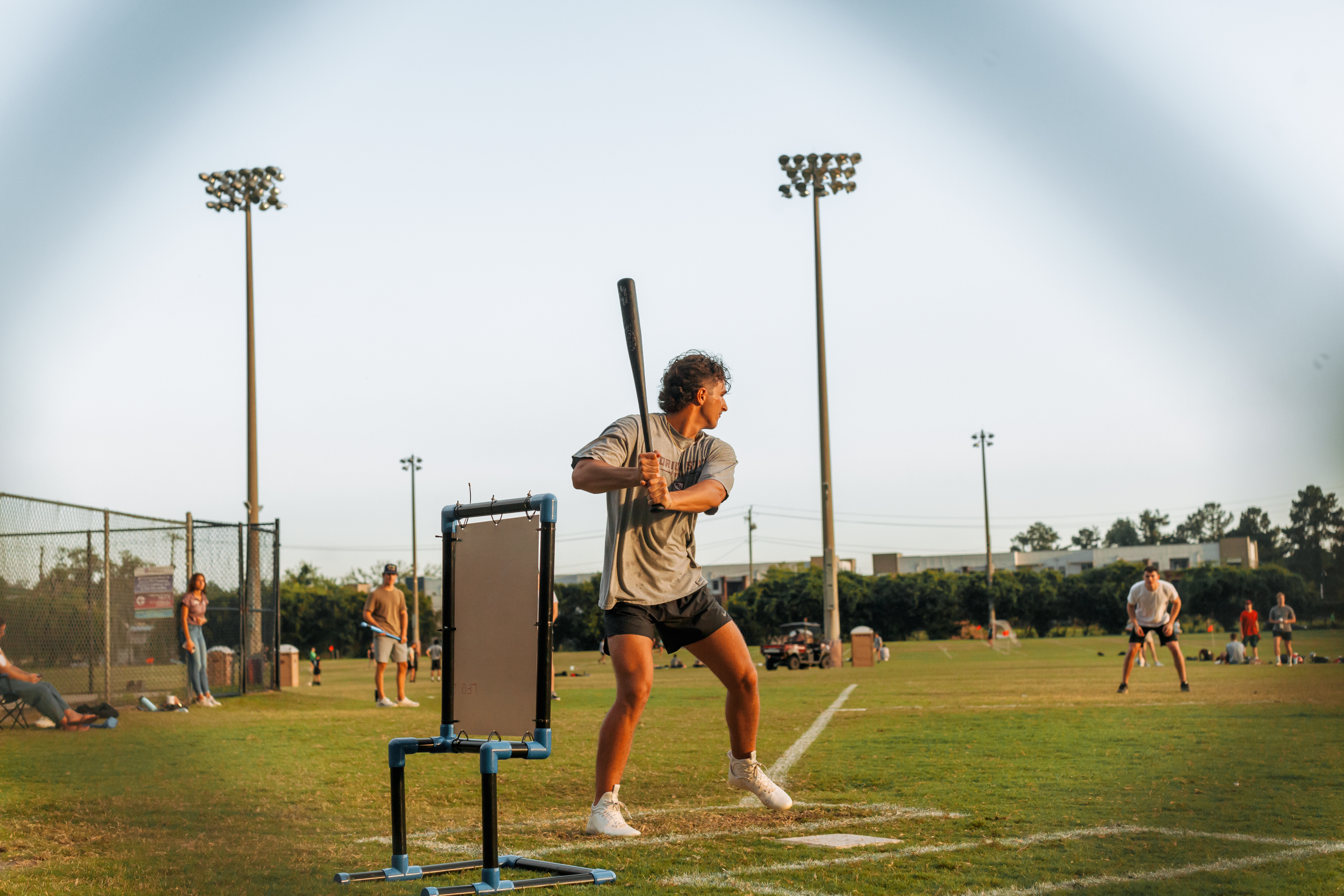Playing Rules
Updated August 14, 2024
General Rules
Florida State University does not provide accident insurance coverage for injuries received by Intramural Sports participants. Each participant should make sure that they have coverage either through family policies or the student insurance plan.
Florida State University PROHIBITS possession or consumption of alcoholic beverages on University property. Smoking and the use of smokeless tobacco is also prohibited at Campus Recreation facilities. This includes the Rec SportsPlex, Main Campus Fields, Westside Courts, and Tully Gym. Violators will be asked to leave the area. Failure to do so can result in forfeiture of the contest, suspension of individuals and/or teams, and appropriate action by the Office of Student Conduct & Community Standards and/or the FSU Police.
Sport Rules
Current Amateur Softball Association (ASA) rules will govern play with the following modifications:
I. GENERAL ELIGIBILITY
1. Participation is limited to currently-enrolled, fee-paying FSU students, faculty members, and full-time staff. FAMU & TCC students and members of the community are not eligible.
2. In order to participate in an intramural contest, each player must present their current, valid FSUCard. Check-in takes place at designated sign-in locations at the facility, not at the fields or courtside.
3. Additional information regarding player eligibility, team rosters, and participant check-in is available in the Seven Principles of Intramural Sports, available online at the FSU Intramural Sports web site and in the Intramural Sports Office at the Main Campus Fields (1001 W. St. Augustine Street). Requests for exceptions to any policy must be directed to the IM administrative staff during regular weekday business hours in the Intramural Sports Office. No exceptions are granted at the fields or courts.
II. TEAM COMPOSITION
1. Players can compete on one team, regardless of league classification.
2. Four (4) players will play on the field. Teams must have 3 players to start a game.
3. A team’s batting line-up must include all four fielders. In addition, teams have the option to bat an additional 2 players (to total 6 in the batting line-up). The decision on the number of players in a team’s batting line-up must be made prior to the game. The batting order must be listed on the scoresheet prior to game time.
4. Once a game has begun, late arriving players may not be added to the batting order and will become substitutes. In the event that a team begins a game with 3 players, a late arriving player may be added to the line-up in order to field 4 players. In this case, one late arrivals will be permitted to bat. Any other late arrival will become substitutes only.
5. A team’s roster may include an unlimited number of players.
III. EQUIPMENT
1. All players must wear shoes. Tennis shoes, soft-soled shoes, and one-piece softball shoes are legal. Metal spikes or cleats with metal exposed are not allowed. Any player caught wearing metal spikes will be ejected from the game. Sandals, flip-flops, and boots are not permitted.
2. Bats, balls, and bases will be provided by the Intramural Sports staff at the game site. Teams must use the equipment provided by Intramural Sports. No outside bats, balls, or bases are permitted.
3. Fielders may NOT use baseball/softball gloves or mitts or any other catching equipment. Hats may be worn but may NOT be used to catch the ball.
4. Select jewelry is allowed to be worn during intramural competition.
Below is a list of jewelry that is not allowed:
• Hard plastic / metal jewelry including rings, watches, bracelets, etc.
• Jewelry with loose hanging loops / hoops
• Non-stud piercings
If a finger could fit through the space of a loose piece of jewelry, then it must be taken off. Sport specific Jewelry Policies may still apply. There is absolutely no jewelry allowed beneath the elbow in the following sports:
• Flag football (7v7 & 4v4)
• Basketball (3v3 & 5v5)
• Volleyball (Indoor & Sand)
If necklaces are worn, they must be tucked in and always remain tucked in. Individuals wearing religious or medical alert jewelry will be allowed to participate while wearing jewelry containing necessary information. In such cases, the jewelry should be taped to the skin with the medical information visible. The Intramural Sports Staff and Supervisors have the final say on approved jewelry for each sport.
IV. GROUND RULES
1. The distance between each base will be approximately 45 feet. The pitching rubber is approximately 30 feet from home plate.
2. The home run boundary will be set at approximately 90 feet from home plate.
V. GAME TIME & LENGTH
1. Game time is forfeit time. A team needs at least 3 legal players to begin the game.
2. Each game has a 35-minute or 7-inning limit. Any inning started before the end of the 35-minute time period will be completed. No innings will begin after 35 minutes.
3. Regular season games can end in a tie. Extra innings will be played only if they start before the 35-minute time limit. All tournament games will continue until a winner is determined.
4. There is no run-limit per inning and no mercy rule.
VI. INCLEMENT WEATHER
1. FSU Intramural Sports reserves the right to postpone or reschedule a contest if circumstances warrant such action. Regular season games cancelled by rain are generally not rescheduled. Contests postponed due to other reasons may or may not be rescheduled at the discretion of the Intramural Sports staff.
2. In the case of inclement weather, the Intramural Sports staff will not make a decision regarding the playing of games until after 4:00 pm. For information on cancellations, use the FSU Rec app or visit the Intramural Sports web site.
3. A game stopped because of inclement weather is a regulation game if four or more innings (3 1/2 if the home team is ahead) have been played. In the event that a game is stopped in the middle of an inning, the official score will revert the score at the end of the last complete inning.
VII. PITCHING
1. In the act of delivering the ball to the batter, the pivot foot must remain in contact with the pitcher’s rubber until the ball leaves the pitcher’s hand.
2. (Slow-pitch) A legal delivery shall be a ball that is delivered underhand or overhand at a moderate speed. In the event of repeated violations by a pitcher, the IM site supervisor may intervene to rule on the situation.
(Fast-pitch) A legal delivery shall be a ball that is delivered underhand or overhand at any speed.
3. A called strike will be determined by hitting a target located behind home plate. The ball may not contact the ground prior to being hit.
4. The pitcher has 10 seconds between pitches. If they exceed this time, an automatic ball will be called.
VIII. BATTING
1. The batter must keep two hands on the bat prior to and when contacting the ball. One-handed swings that hit the ball into fair or foul territory will result in the batter being called out.
2. Batted balls must clear the 20-foot bunt line drawn in front of home plate to be considered a fair ball. Batted balls that roll dead inside this area OR are fielded by the defense within this area will be considered foul balls. The ball must roll completely over the line to be fair.
3. Batters start with the traditional 0-0 count. A batter may walk on four (4) balls or strike out on swinging or called 3rd strikes. There are no foul outs.
5. There is no bunting. The batter must take a full swing at the ball. A batter who bunts the ball is out and the ball is immediately dead.
6. In the event that a player is on base when it is their turn to bat, the player shall vacate the base to come to bat. The runner simply loses their chance to score a run. No ghostrunner will be permitted. No out will be recorded. No other runners will advance.
IX. RUNNING
1. Runners cannot lead off or steal bases. Baserunners may leave the base when the pitch is contacted by the batter. Runners who leave base prior to the ball being contacted by the batter are out.
2. If the runner makes contact with a base and the base slides away from its original position on the field, the runner is safe (if it occurred before the tag or putout) and is not liable to be put out while base is dislodged. If the runner attempts to advance to another base, they are liable to be put out and must return to the position of the dislodged base (not the original position of the base).
3. The base path for a runner is the direct line between the player and the base to which they are advancing at the time a play is being made on that specific base runner and the three feet to either side of that direct path. Note: this path may be different from the straight line connecting two bases. For example, a player who has run past 1st base a distance of about 10 feet decides to run for second. Their base path for any tag plays is the direct line from where they made their turn towards 2nd base (10 feet down the line from 1st) and 2nd base. This is different from the direct line from 1st to 2nd base. For plays between home plate and 1st base, the runner shall run in the 3-foot lane of the foul side of the foul line.
4. A player who runs outside their base path (including the 3-foot lanes on either side) in an attempt to avoid a tag shall be declared out.
5. Baserunners are responsible for avoiding all collisions with fielders anytime a fielder is making a play on the ball (fielding, throwing, catching). If the baserunner does not avoid the collision, play will be ruled dead, the baserunner is called out, the batter is awarded first (unless involved in the collision), and all runners return to their original base unless forced to the next base.
6. A defensive player cannot stand in the base path or obstruct the path of a base runner unless they are making a play on the ball. In the event the defense obstructs a runner, the umpire shall award the runner and each other runner affected by the obstruction the bases they would have, in the umpire’s opinion, reached had there been no obstruction. It is also obstruction when a fielder without the ball fakes a tag. In this case, bases are awarded as a normal obstruction AND the fielder will be ejected from the game.
7. Any runner in fair territory and not in contact with a base that is struck by a fair batted ball is out except when
(a) the ball has passed an infielder and in the judgement of the umpire, no other fielder had a chance to make an out,
(b) when a runner is hit with a fair batted ball over foul territory and no other fielder had a chance to make an out, or
(c) when a runner is touched with a fair batted ball after it is touched by any fielder, including the pitcher.
In the event of one of these 3 exceptions, all runners must return to their previously occupied base and the batter-runner is awarded first base. If the award of first to the batter-runner causes another runner to be forced, that runner will advance to the next base.
8. In case of a possible double play, the baserunner must get out of the way of the thrown ball. Baserunners who fail to get out of the way may be charged with interference resulting in both the baserunner and the batter-runner being called out on the play.
9. When a defensive player has the ball and is waiting for the runner, and the runner deliberately, with great force, crashes into the defensive player, the runner is declared out and will be ejected from the game. The ball will be declared dead and all runners must return to the last base they legally occupied. If the act is to be judged flagrant, the runner closest to home will also be called out.
10. There are no courtesy runners.
X. FIELDING
1. Each team must provide a pitcher. There are no other defensive restrictions.
2. The offensive team is responsible for retrieving pitched balls that are not hit to return to the pitcher for the next pitch. The offensive team has 10 seconds to return the ball to the pitcher or an automatic strike will be called.
3. The batter is out in situations similar to softball (forceouts, flyouts, etc). Runners may NOT be hit by a thrown ball — “pegged” — to be put out.
4. There is no infield fly rule.
5. Near the outfield fence / home run boundary and out-of-play lines, in order for an out to be recorded, the fielder must catch a fly ball and remain in play following the catch. Balls carried over the home run boundary by a fielder will be ruled home runs. Foul balls carried over an out-of-play sideline will be ruled foul balls. Fair balls carried over an out-of-play sideline will result in the batter and all runners being awarded 2 bases.
6. Balls that bounce over or roll under the outfield fence in fair territory shall result in a ground-rule double for the batter.
7. Overthrows that land out of play will result in the following awards:
A. On an initial overthrow by an infielder, the award is 2 bases from the time of the throw; i.e., batter gets second base, any baserunners are awarded 2 bases from where they were at the time of the throw.
B. On an overthrow by the outfielder, the award is 2 bases from the time the fielder releases the ball, not when it goes out of play; i.e., if a player is one step away from second when the outfielder released the ball, the runner is awarded second and third.
8. All base awards are based on the position of the lead runner. For example, if two players are between 1st and 2nd at the time of an overthrow which lands out of play, the first runner will be awarded 2nd and 3rd (two bases) and the second runner will receive 2nd base only.
XI. OTHER RULES
1. There will be a coin-toss prior to each game to determine the home team.
2. A player who is bleeding or has blood on their uniform cannot participate until the bleeding is stopped or the uniform is changed.
A. If the player accomplishes this task within a reasonable time (to be determined by the supervisor), the player may remain in the game.
B. If the situation is not handled in a reasonable amount of time, the player must leave the game and be replaced. If no substitutes are available, play will continue without the player. The player, then, may re-enter the game when they are deemed legal for participation.
3. The pitcher may receive a maximum of 3 warm-up pitches prior to each inning. Infield practice is prohibited prior to any inning.
XII. SPORTING BEHAVIOR
1. The mission of Intramural Sports is to provide a recreational environment for the University community which is safe and enjoyable. While the game atmosphere is often competitive, ensuring participant safety, providing a fun, social atmosphere, and promoting sporting behavior among participants, spectators, and team followers are our primary concerns. The game atmosphere should remain good-natured at all times. Participants shall maintain good sporting behavior throughout their participation in all facets of the intramural program.
2. The Sporting Behavior Rating System is intended to be an objective scale by which teams’ attitude and behavior can be assessed throughout the intramural sports league and playoff seasons. Behavior before, during, and after an intramural sports contest is included in the rating. The team captain is responsible for educating and informing all players and spectators affiliated with their team about the system.
3. A team is responsible for the actions of the individual team members and spectators related to it. Additionally, FSU Intramural Sports does not recognize the use of coaches. Only the team captain shall speak to the officials regarding administrative matters (protests, ejections, disqualifications, etc). Furthermore, the team captain’s efforts in assisting officials/staff to calm difficult situations and to restrain troubled teammates are key to controlling team conduct.
4. Sporting behavior is vital to the conduct of every Intramural contest. In order to encourage proper conduct during games, officials, administrative personnel, and supervisors shall make decisions on whether to warn, penalize or eject players or teams for poor behavior. These decisions are final. The Intramural Sports administrative staff will rule on further penalties as a result of unsporting conduct.
5. Each participant should choose their team members carefully, as all team members will suffer the consequences of any disciplinary action taken by the Intramural Sports staff against that team for violation of the intramural rules and sporting behavior guidelines. Protests or appeals of sporting behavior ratings will not be recognized. The Intramural Sports administrative staff reserves the right to review any rating given to a team.
6. Additional information regarding team and participant sporting behavior including the rating method, factors, and scale is available in the Sporting Behavior Principle of the Seven Principles of Intramural Sports, available online at the FSU Campus Recreation web site.






